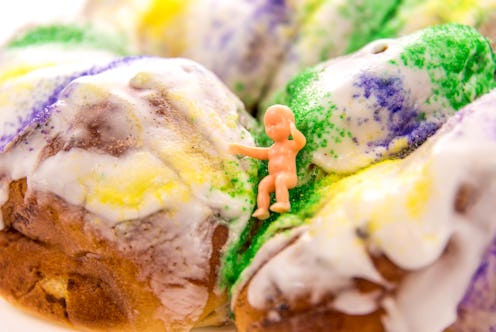Life
This Is Why There's A Baby In Your King Cake
When participating in New Orlean's ebullient Mardi Gras season, one can expect beads, parades, costumes, and a sweet seasonal treat known as king cake. But first timers tasting the ring-shaped pastry may ponder a curious question: Why is there a baby in king cake? Indeed, it may seem unfair for a baker to hide a tiny plastic baby in a piece of cake, especially with the possibility of chipping a tooth — but the finder of the trinket should actually consider themselves lucky. Finding a small treasure in the king cake is an venerated Mardi Gras tradition, dating all the way back to the 19th century, and it comes with both rewards and responsibility.
King cake is traditionally served in the months between the celebration of Epiphany and Fat Tuesday. The pastry, named in honor of Three Kings Day, acts as the featured centerpiece at many of the feasts and parties thrown during the lead-up to Lent. Modern Louisiana-style king cake is a ring-shaped braided pastry (sometimes stuffed with a sweet filling), often topped with icing and purple, green, and gold sprinkles, representing justice, faith, and power.
The king cake tradition of eating a wreath-shaped cake symbolic of a crown to celebrate Three Kings Day is thought to have originated in Spain and France of Old World Europe, but that's not where the baby thing started. The tradition of the cake was later brought to America around 1870, from which it spread to parts of Latin America — and it was in New Orleans that the modern custom of hiding a figurine in the king cake was born.
Even that, though, goes back a little further: The act of hiding a treasure in a celebratory cake may actually date back to pre-Christian Celtic Yule Feast. According to Go Nola, during the celebrations, a king would be chosen from among the male commoners and dubbed "Lord of Misrule" for the duration of the party. To determine who would be chosen, a bread would be baked and each person would receive a slice. The one to find a silver bean in his piece would be crowned king for the night, and would be responsible for bringing a cake to the next event.
The public celebration of Mardi Gras in New Orleans is said to have started in 1857. Years later, a group called the Twelfth Night Revelers (TNR) reintroduced the king cake tradition to signify the start of Carnival. "TNR first paraded through the streets of New Orleans in 1870, ending their evening with a tableau bal masque," writes Go Nola. "At their ball, TNR brought out a large king cake with a gold bean inside that was sliced up and served to the ladies in attendance."
In the 1930s and '40s, commercial bakeries began to produce king cakes, and the demand for the celebratory pastry grew. Donald Entringer, president of McKenzie’s Bakeries, started including trinkets inside his cakes per request of a local Carnival krewe. After much trial and error (exchanging the bean for a pecan or ring), Entringer started baking French porcelain dolls into his cakes. The story goes that once he ran out of the dolls, he replaced them with pink plastic babies sourced from the French Quarter. After Entringer secured permission from the health department, the babies became standard of any king cake made in New Orleans.
For what it's worth, it's up for debate whether the baby is Jesus; some sources say it is, while others are adamantly against the idea. I'm going to take that as an indication that we can all just decide the Jesus debate for ourselves.
Today, the babies often are left out of the king cake while they're in the oven to the chagrin of some Mardi Gras purists, and instead arrive in separate pouches for the hosts to do with as they please. The person who finds the plastic baby is dubbed king or queen of the party, and must bring a king cake to the next celebration! Who knew finding plastic in your dessert could be so fun?
Image: Casey E Martin/Fotolia
